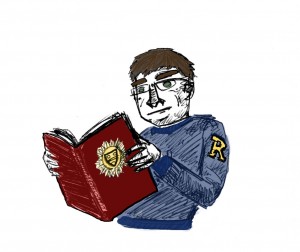It is difficult to believe that the 2013 spring semester is already half over. For most students at UR, this means finding housing for next year or beginning to compose a fall schedule. For the students in the class of 2013, though, this means that graduation is quickly approaching.
Once these students leave school, however, they will not be left without a record of their fond memories and achievements here; there is work already well underway on the University’s annual Interpres yearbook for this year’s graduating class.
The Interpres Yearbook has been an annual feature of the University since 1859. This first edition, founded by the fraternity literati, was just four-pages long. The publication was titled “Interpres Universitatis” (literally meaning “an interpreter of the movements of college life”), and this Interpres label has survived for more than 150 years.
The publication that will go home with the class of 2013 is much different from the books of years past.
UR’s Yearbook Advisor and graphic artist Jennelle Hart was able to display some of the archived yearbooks — the earliest preserved being the class of 1908.
“[Our] yearbooks have changed a lot over time,” Hart said.
The look of the books themselves is far different from what we are accustomed. To today, the 1911 edition has a handsome, velvety, green cover emblazoned with gilded gothic text. Inside, distinguished black-and-white portraits fill the pages, along with each student’s major. Each student’s portrait was given much more space as class sizes at the time hovered around 50 students. Even more interesting are the faculty portraits of these older publications, amongst which are Henry Fairfield Burton, Herman LeRoy Fairchild, William Carey Morey, and others whose names are recognizable as the titles for some of our campus buildings. These portraits look like figures from a history textbook on the turn of the century, and represent a fascinating time capsule of our University’s history.
Unlike 100 years ago, UR students today can expect a glossy, hardcover book with full-color pictures inside. Although growing class sizes have crammed more portraits onto each page, today’s yearbooks also contain lighter additions to the formal portrait section, including many candid shots of fun campus events such as Yellowjacket and Meliora Weekends. The yearbook staff also creates a unique features section each year. This year’s feature will include Q&A surveys as answered by professors and Students’ Association officers. Unlike the design of some of the older yearbooks, Hart knows that seniors want a “fun” design.
“They don’t want it to be such a stoic read,” she added.
Another feature of the modern Interpres book is the cover. Each year, Hart uses her expertise in graphic design to advise the yearbook’s staff on creating a cover that fits that year’s particular theme. In recent years, Hart has seen students gravitate towards more modern and less traditional designs. For example, the 2012 cover did away with the ubiquitous blue and yellow, opting instead for a fresh and unexpected purple and red.
“Yellow and blue were so done… and they wanted to be different… I tried to push them to think outside the box,” Hart said.
Although the cover for this year is already done, it is being kept top secret until the books arrive. The revealing of the cover is an exciting surprise for seniors, but Hart hinted that it would follow last year’s precedent of a simpler, more modern design that “has a lot to do with dandelions.”
Despite all the changes the Yearbook has undergone through the years, the book still shares several features with its archaic predecessors, about which seniors will surely get sentimental. The book also continues to feature sections dedicated to athletics, Greek life, and as many campus clubs as possible.
As always, there will be pictures of fellow classmates to look back on and those associated memories to recall for many years beyond graduation.
Tausanovitch is a member of
the class of 2016.



